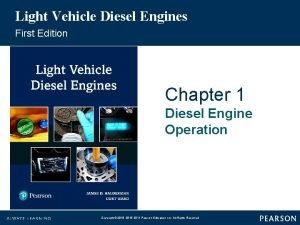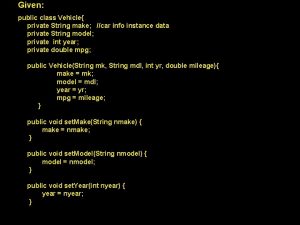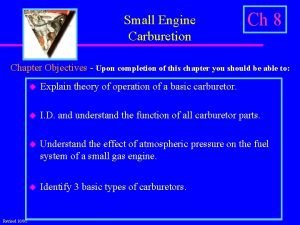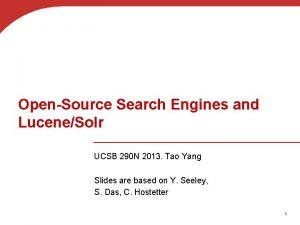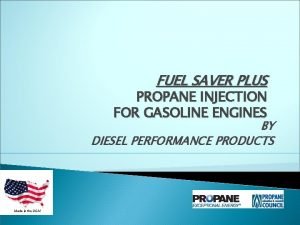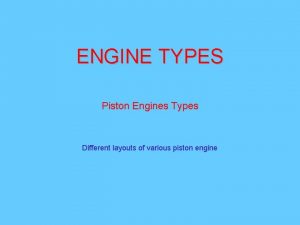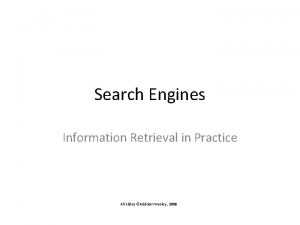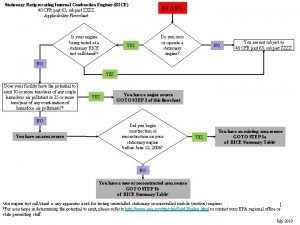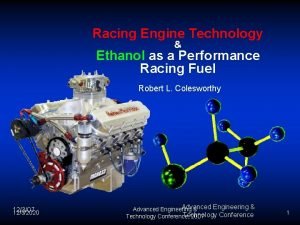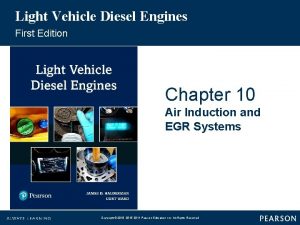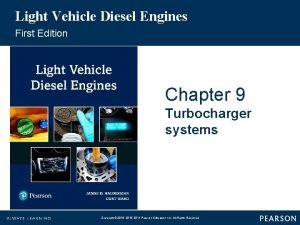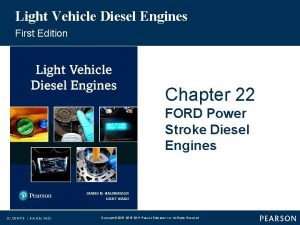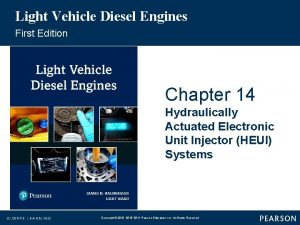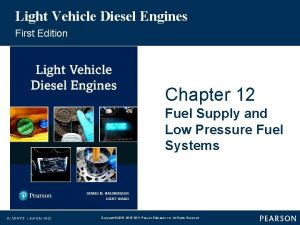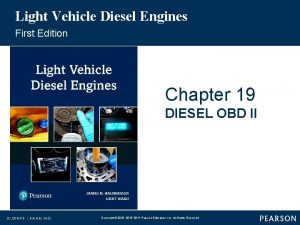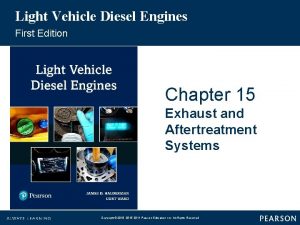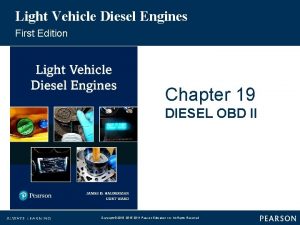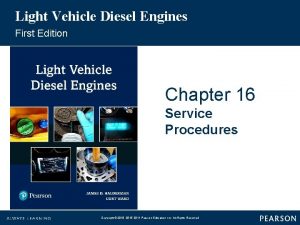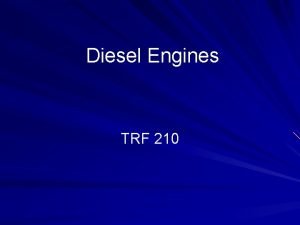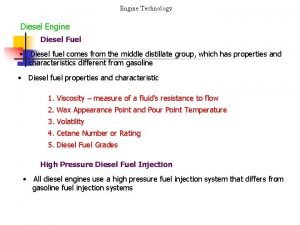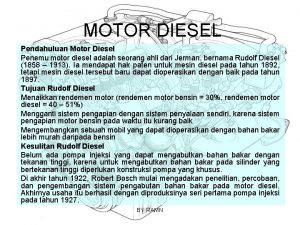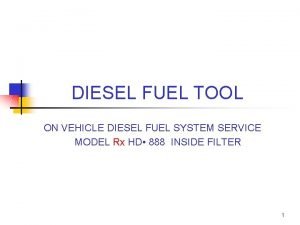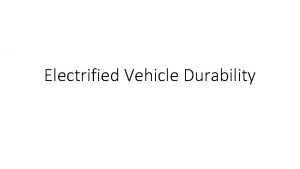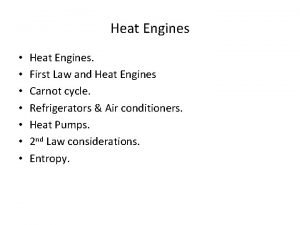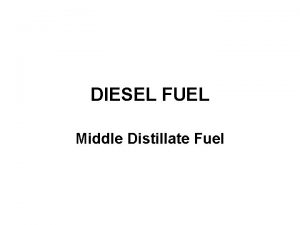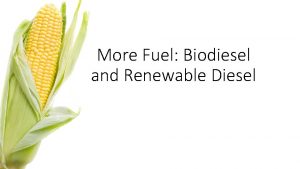Light Vehicle Diesel Engines First Edition Chapter 11






































- Slides: 38

Light Vehicle Diesel Engines First Edition Chapter 11 DIESEL & BIODIESEL FUELS Copyright © 2018, 2015, 2011 Pearson Education, Inc. All Rights Reserved

LEARNING OBJECTIVES (1 of 1) 11. 1 Explain diesel fuel specifications. 11. 2 List the advantages and disadvantages of biodiesel. 11. 3 Discuss API gravity. 11. 4 Explain E-diesel specifications. Copyright © 2018, 2015, 2011 Pearson Education, Inc. All Rights Reserved

Diesel Fuel (1 of 14) • Features of Diesel Fuel – – Contains 12% more heat energy Than same amount of gasoline Fuel in a diesel engine not ignited with spark Heat generated by high compression Copyright © 2018, 2015, 2011 Pearson Education, Inc. All Rights Reserved

Diesel Fuel (2 of 14) • Diesel Fuel Requirements – Cleanliness: fuel must be clean & free from water – Low-temperature fluidity – Flow freely at all expected ambient temperatures – Cloud point: § low-temperature point when waxes in most diesel fuels tend to form crystals that clog fuel filter Copyright © 2018, 2015, 2011 Pearson Education, Inc. All Rights Reserved

Diesel Fuel (3 of 14) • Cetane Number – Opposite of octane number for gasoline – Measure of ease with which fuel can be ignited – Determines fuel’s ability to start engine § At low temperatures § Determines ability to provide § Smooth warm-up and combustion Copyright © 2018, 2015, 2011 Pearson Education, Inc. All Rights Reserved

Diesel Fuel (4 of 14) • Cetane Number – Should be between 45 and 50 – Higher Cetane rating – More easily fuel is ignited Copyright © 2018, 2015, 2011 Pearson Education, Inc. All Rights Reserved

Diesel Fuel (5 of 14) • Sulfur Content – – Very important to life of engine Sulfur creates sulfuric acid during combustion Can damage engine components Federal regulations limit sulfur content § < 15 ppm § High-sulfur fuel contributes to acid rain Copyright © 2018, 2015, 2011 Pearson Education, Inc. All Rights Reserved

Diesel Fuel (6 of 14) • Diesel Fuel Color – Clear or GREEN – Intended for use on streets and highways – RED: to be used on farms and off-road use Copyright © 2018, 2015, 2011 Pearson Education, Inc. All Rights Reserved

Diesel Fuel (7 of 14) • Grades of Diesel Fuel – ASTM classifies diesel fuel by volatility § (boiling range) – Grade #1 § Lowest boiling point, lowest cloud & pour points – GRADE #2 § Higher boiling point, cloud point, & pour point § Constant speed and high loads § Most diesel is grade #2 Copyright © 2018, 2015, 2011 Pearson Education, Inc. All Rights Reserved

Figure 11 -1(a) Regular diesel fuel on the left has a clear or greenish tint, whereas fuel for off-road use is tinted red for identification. Copyright © 2018, 2015, 2011 Pearson Education, Inc. All Rights Reserved

Figure 11 -1(b) A fuel pump in a farming area that clearly states the red diesel fuel is for off-road use only. Copyright © 2018, 2015, 2011 Pearson Education, Inc. All Rights Reserved

Diesel Fuel (8 of 14) • Grade #1 – Lower BTU content— – Less heat per pound of fuel – Use during low-temperature (winter) operation – Produces less heat per pound of fuel § Compared to Grade #2 – May be specified for use in engines – With frequent changes in load and speed Copyright © 2018, 2015, 2011 Pearson Education, Inc. All Rights Reserved

Diesel Fuel (9 of 14) • Grade #2 – Higher boiling point, cloud point, pour point – Usually specified with constant speed and high loads § Long-haul trucking and automotive diesel applications Copyright © 2018, 2015, 2011 Pearson Education, Inc. All Rights Reserved

Diesel Fuel (10 of 14) • Diesel Fuel Specific Gravity Testing – Density should be tested whenever a driveability concern § Measured in units of API gravity § Arbitrary scale expressing gravity or density of liquid petroleum products § Scale calibrated in terms of degrees API Copyright © 2018, 2015, 2011 Pearson Education, Inc. All Rights Reserved

Diesel Fuel (11 of 14) • Diesel Fuel Specific Gravity Testing – Fuel with least specific gravity has highest API gravity – Normal API gravity for #1 diesel fuel 39 to 44 (typically 40) – Normal API gravity for #2 diesel fuel 30 to 39 (typically 35) – Hydrometer calibrated in API gravity units used to test diesel fuel Copyright © 2018, 2015, 2011 Pearson Education, Inc. All Rights Reserved

Figure 11 -2 Testing the API viscosity of a diesel fuel sample using a hydrometer. Copyright © 2018, 2015, 2011 Pearson Education, Inc. All Rights Reserved

Chart 11 -1 API gravity scale is based on specific gravity of fuel. Copyright © 2018, 2015, 2011 Pearson Education, Inc. All Rights Reserved

Chart 11 -1 (continued) API gravity scale is based on specific gravity of fuel. (1 of 2) Copyright © 2018, 2015, 2011 Pearson Education, Inc. All Rights Reserved

Chart 11 -1 (continued) API gravity scale is based on specific gravity of fuel. (2 of 2) Copyright © 2018, 2015, 2011 Pearson Education, Inc. All Rights Reserved

Diesel Fuel (12 of 14) • Diesel Fuel Heaters – Help prevent power loss and stalling in cold weather – Placed in fuel line between tank and primary filter – Some heaters thermostatically controlled § Fuel can bypass heater once operating temperature reached Copyright © 2018, 2015, 2011 Pearson Education, Inc. All Rights Reserved

Diesel Fuel (13 of 14) • Ultra-Low-Sulfur Diesel Fuel – Diesel engines manufactured to 2007 or newer standards must use ultra-low-sulfur diesel fuel – Contains less than 15 ppm of sulfur § Older, low-sulfur specification was 500 ppm Copyright © 2018, 2015, 2011 Pearson Education, Inc. All Rights Reserved

Diesel Fuel (14 of 14) • Ultra-Low-Sulfur Diesel Fuel – Purpose to reduce emissions of sulfur oxides and particulate matter – Emission controls on newer engines require ultra-low-sulfur diesel (ULSD) for reliable operation – ULSD will eventually replace all low-sulfur diesel fuel Copyright © 2018, 2015, 2011 Pearson Education, Inc. All Rights Reserved

How Can You Tell If Gasoline Has Been Added to Diesel Fuel by Mistake? If gasoline has been accidentally added to diesel fuel and is burned in diesel engine, result can be very damaging to engine. Gasoline can ignite faster than diesel fuel, which would tend to increase temperature of combustion. High temperature can harm injectors and glow plugs, as well as pistons, head gaskets, &other major components. If contaminated fuel is suspected, first smell fuel at filler neck. If fuel smells like gasoline, then tank should be drained and refilled with diesel fuel. If smell test does not indicate a gasoline smell (or any rancid smell), then test a sample for proper API gravity. Copyright © 2018, 2015, 2011 Pearson Education, Inc. All Rights Reserved

How Can You Tell If Gasoline Has Been Added to Diesel Fuel by Mistake? NOTE: Diesel fuel designed for onroad use should be GREEN in color. RED diesel fuel (high sulfur) should only be found in off-road or farm equipment. Copyright © 2018, 2015, 2011 Pearson Education, Inc. All Rights Reserved

What Are Diesel Fuel Additives? Several types and many brands of additives that are designed to be added to diesel fuel. These types of additives include: 1. Winter Conditioners—Winter conditioners designed to reduce Cold Filter Plugging Point (CFPP). CFPP is the lowest temperature at which a specified volume of diesel type of fuel can pass through a standardized filtration device 2. Multi-functional Conditioners—Many multifunctional additives increase Cetane rating helps keep injectors clean. Raising Cetane rating power & economy Improved. 3. Microbicide—Microbes can grow in diesel fuel at the junction between the water and the diesel. Water heavier near bottom of the tank. Microbicide kills microorganisms including bacteria and fungi. Always follow OEM recommended service procedures and for best results Copyright © 2018, 2015, 2011 Pearson Education, Inc. All Rights Reserved

FIGURE 11– 3 Many diesel fuel additives increase the cetane rating which results in improved fuel economy. Copyright © 2018, 2015, 2011 Pearson Education, Inc. All Rights Reserved

Biodiesel (1 of 2) • Features of Biodiesel – Purchasing in bulk quantities decreases cost of fuel – Maintains similar horsepower, torque, fuel economy – Has higher Cetane number than conventional diesel, increasing engine performance Copyright © 2018, 2015, 2011 Pearson Education, Inc. All Rights Reserved

FIGURE 11– 4 A pump decal indicating that the biodiesel fuel is ultra-low-sulfur diesel (ULSD) and must be used in 2007 and newer diesel vehicles. Copyright © 2018, 2015, 2011 Pearson Education, Inc. All Rights Reserved

Biodiesel • Features of Biodiesel – Nontoxic; safe to handle, transport, and store – Maintenance requirements for B 20 and petrodiesel vehicles are same – Acts as a lubricant; can add to life of fuel system components Copyright © 2018, 2015, 2011 Pearson Education, Inc. All Rights Reserved

I Thought Biodiesel Was Vegetable Oil? 1 Biodiesel is vegetable oil with glycerin component removed by means of reacting vegetable oil with a catalyst. The resulting hydrocarbon esters are 16 to 18 carbon atoms in length, almost identical to petroleum diesel fuel atoms. This allows the use of biodiesel fuel in a diesel engine with no modifications needed. Biodiesel-powered vehicles do not need a 2 nd fuel tank, whereas vegetable-oil-powered vehicles do. Copyright © 2018, 2015, 2011 Pearson Education, Inc. All Rights Reserved

I Thought Biodiesel Was Vegetable Oil? 2 3 main types of fuel used in diesel engines: • Petroleum diesel, fossil hydrocarbon 16 carbon atoms. Biodiesel, a hydrocarbon with a carbon chain length 16 to 18 carbon atoms. Vegetable oil is a triglyceride with a glycerin component joining 3 hydrocarbon chains of 16 to 18 carbon atoms each, called straight vegetable oil (SVO). Pure plant oil (PPO)—most often used in Europe to describe SVO. Waste vegetable oil (WVO)—this oil could include animal or fish oils from cooking. Used cooking oil (UCO)—used when oil may or may not be pure vegetable oil Copyright © 2018, 2015, 2011 Pearson Education, Inc. All Rights Reserved

I Thought Biodiesel Was Vegetable Oil? 3 Vegetable oil is not liquid enough at common ambient temperatures for use in diesel fuel delivery system designed for lower-viscosity petroleum diesel fuel. Vegetable oil needs to be heated to obtain a similar viscosity to biodiesel/petroleum diesel. This means that a heat source needs to be provided before fuel can be used in a diesel. This is achieved by starting on petroleum diesel or biodiesel fuel until engine heat can be used to sufficiently warm a tank containing vegetable oil. It also requires purging fuel system of vegetable oil with petroleum diesel or biodiesel fuel prior to stopping engine to avoid vegetable oil thickening and solidifying in fuel system away from heated tank. Use of vegetable oil in its natural state does, however, eliminate need to remove glycerin component. Many vehicle and diesel engine fuel system suppliers permit use of biodiesel fuel that is certified as meeting testing standards. None permit use of vegetable oil in its natural state. Copyright © 2018, 2015, 2011 Pearson Education, Inc. All Rights Reserved

E-Diesel Fuel (1 of 3) • Definition of E-Diesel – Also called diesohol outside of U. S. – No. 2 diesel fuel containing up to 15% ethanol – Typical blend levels have from 8% to 10% ethanol Copyright © 2018, 2015, 2011 Pearson Education, Inc. All Rights Reserved

E-Diesel Fuel (2 of 3) • Cetane Rating of E-Diesel – – Higher Cetane number Shorter the delay between injection and ignition Normal diesel fuel has Cetane number about 50 Adding 15% ethanol lowers Cetane number Copyright © 2018, 2015, 2011 Pearson Education, Inc. All Rights Reserved

E-Diesel Fuel (3 of 3) • Cetane Rating of E-Diesel – To raise Cetane number, Cetane-enhancing § Additive added to E-diesel – E-diesel has better cold-flow properties – Than conventional diesel – Heat content about 6% < conventional diesel Copyright © 2018, 2015, 2011 Pearson Education, Inc. All Rights Reserved

E-Diesel Fuel (4 of 4) • Cetane Rating of E-Diesel – – – Emissions of PM, carbon monoxide NOX significantly reduced Considered to be experimental Can be used legally in off-road applications or in mass-transit buses with EPA approval Copyright © 2018, 2015, 2011 Pearson Education, Inc. All Rights Reserved

Summary (1 of 2) • Diesel fuel produces 12% more heat energy than the same amount of gasoline. • Diesel fuel requirements include cleanliness, lowtemperature fluidity, and proper Cetane rating. • Emission control devices used on 2007 and newer engines require the use of ultra-low-sulfur diesel (ULSD) that has less than 15 parts per million (PPM) of sulfur. • The density of diesel fuel is measured in a unit called API gravity. Copyright © 2018, 2015, 2011 Pearson Education, Inc. All Rights Reserved

Summary (2 of 2) • The Cetane rating of diesel fuel is a measure of the ease with which the fuel can be ignited. • Biodiesel is the blend of vegetable-based liquid with regular diesel fuel. Most diesel engine manufacturers allow the use of a 5% blend, called B 20, without any changes to the fuel system or engine. • E-diesel is a blend of ethanol with diesel fuel up to 15% ethanol by volume. Copyright © 2018, 2015, 2011 Pearson Education, Inc. All Rights Reserved
 Light vehicle diesel engines
Light vehicle diesel engines Automotive engines 8th edition
Automotive engines 8th edition Light light light chapter 23
Light light light chapter 23 Into the light chapter 22
Into the light chapter 22 Chapter 22
Chapter 22 Public class vehicle private string name
Public class vehicle private string name Chapter 8 carburetion answers
Chapter 8 carburetion answers Chapter 5 principles of engine operation
Chapter 5 principles of engine operation Using mis 10th edition
Using mis 10th edition Chapter 1
Chapter 1 When sharing the road with a light rail vehicle you
When sharing the road with a light rail vehicle you Troubleshooting small engines
Troubleshooting small engines Siege engines
Siege engines Meta search engines
Meta search engines Search engines
Search engines Meta search engines compared
Meta search engines compared Open source search engines
Open source search engines Fuel saver plus
Fuel saver plus Types of engine layouts
Types of engine layouts Whats engine displacement
Whats engine displacement Harper industries has $900 million
Harper industries has $900 million Architecture search engines
Architecture search engines Other search engines
Other search engines Information retrieval slides
Information retrieval slides Dot search
Dot search Aircraft engines
Aircraft engines Hz121800
Hz121800 Avaya identity engines
Avaya identity engines Sage game engine
Sage game engine Reciprocating internal combustion engines rice
Reciprocating internal combustion engines rice Race engine technology
Race engine technology Search engines information retrieval in practice
Search engines information retrieval in practice Alliteration in keeping quiet
Alliteration in keeping quiet Www.sbu
Www.sbu Link analysis
Link analysis Engines link analysis and
Engines link analysis and Yarn engines
Yarn engines Compressed air energy storage
Compressed air energy storage Siege engine
Siege engine
